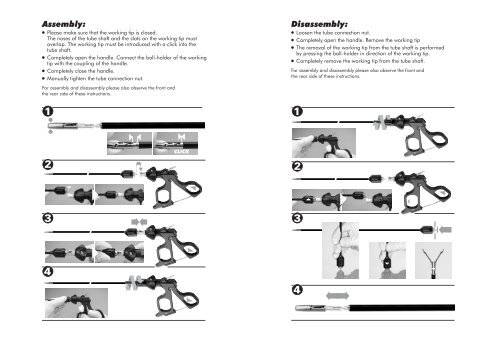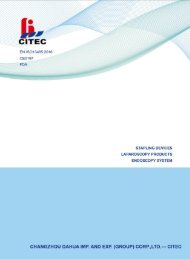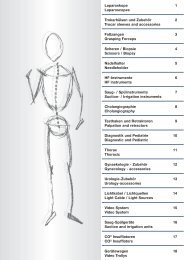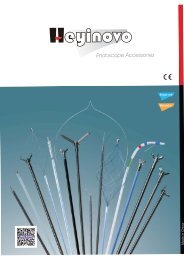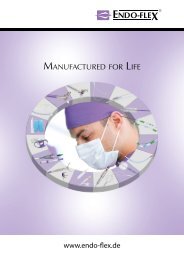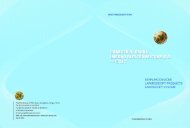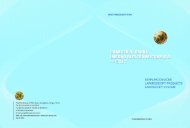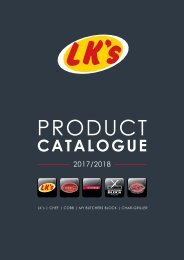Reda - Laparoscopy Instruments Assebmly
Create successful ePaper yourself
Turn your PDF publications into a flip-book with our unique Google optimized e-Paper software.
Assembly:<br />
Please make sure that the working tip is closed.<br />
The noses of the tube shaft and the slots on the working tip must<br />
overlap. The working tip must be introduced with a click into the<br />
tube shaft.<br />
Completely open the handle. Connect the ball-holder of the working<br />
tip with the coupling of the handle.<br />
Completely close the handle.<br />
Manually tighten the tube connection nut.<br />
Disassembly:<br />
Loosen the tube connection nut.<br />
Completely open the handle. Remove the working tip<br />
The removal of the working tip from the tube shaft is performed<br />
by pressing the ball-holder in direction of the working tip.<br />
Completely remove the working tip from the tube shaft.<br />
For assembly and disassembly please also observe the front and<br />
the rear side of these instructions.<br />
For assembly and disassembly please also observe the front and<br />
the rear side of these instructions.<br />
1<br />
1<br />
CLICK<br />
2 2<br />
3<br />
3<br />
4<br />
4
Disinfection, Cleaning,<br />
Care and Sterilization:<br />
Before the first use and after each use the endoscopic tube shaft instruments have to<br />
be carefully cleaned - manually or automatically or by ultrasound.<br />
The instruments have to be disassembled after each use.<br />
If a manual restoration shall be performed, the single parts of the instruments<br />
are immersed in a disinfectant with a high cleaning power. Please observe the<br />
instructions of the disinfectant producer. All the surfaces, included the internal<br />
cavities, lumen and openings, shall get into touch with the solution.<br />
As cleaning means can be used fluff-free clothes and/or soft plastic brushes.<br />
Then thoroughly rinse the single parts to remove the last dirt and residues of the<br />
detergent. For this scope current water can be used. To avoid water stains distilled<br />
or fully ENTSALYENES water should be used for the last rinsing.<br />
The single parts have to be immediately and thoroughly dried. For this scope can be<br />
used absorbing soft clothes and/or if required compressed air.<br />
Before any sterilization movable parts have to be sprayed with a steam-permeable<br />
oil. The sterilization process should be validated according to DIN EN 554<br />
„Sterilization of medical devices - Validation and routine control of sterilization by<br />
moist heat“ / (comparable to ISO 11134 „Sterilization of health care products -<br />
Requirements for validation and routine control - industrial steam sterilization“).<br />
Follow the instructions of the autoclave manufacturer for the sterilization process<br />
without fail.<br />
Maintenance and Repair:<br />
All warranty and service claims are null and void, if the user or a non-authorized<br />
service institution performs repairs. If the disassembled tube shaft instrument has to<br />
be repaired, please send it to:<br />
REDA Instrumente GmbH<br />
Gänsäcker 34<br />
78532 Tuttlingen<br />
Accessories and Spare Parts:<br />
The following parts can be ordered separately:<br />
Handle (with or without ratchet), tube shaft and various working inserts.<br />
Manufacturer:<br />
Date: March 2003<br />
REDA Instrumente GmbH<br />
Gänsäcker 34 · 78532 Tuttlingen<br />
Telefon: 07462-9445-0 · Fax: 07462-9445-20<br />
www.reda-instrumente.de · e-mail: info@reda-instrumente.de<br />
Please observe these manual !<br />
0297<br />
Instructions for Endoscopic Tube Shaft<br />
<strong>Instruments</strong> for monopolar Coagulation:<br />
General Instructions:<br />
These MIC instruments (Minimal Invasive Surgery <strong>Instruments</strong>) are used in laparoscopy<br />
and other minimally invasive procedures for cutting, dissecting, fixation and the taking of<br />
biopsy samples, depending on the design of the working tips. The HF connection (optional)<br />
incorporated in the handle serves for the connection of a HF generator. In this way the<br />
instrument can be used for monopolar coagulation. Please observe the instruction manual<br />
of the HF generator! Keep the voltage power as low as possible to achieve the desired effect,<br />
do not activate ESU when not in contact with target tissue or positioned to deliver energy to<br />
target tissue.<br />
All tube shaft handles with HF connection are equipped with a special overload protection.<br />
Caution:<br />
Federal (USA) Law restricts this device to sale by or in order of physician.<br />
Instructions for Use:<br />
Before any use the instruments have to be checked in relation to the correct assembly and<br />
operation, surface damages, cracks, bent and worn parts.<br />
Damaged and faulty instruments or single parts shall not be used! Special care has to be<br />
taken, when you introduce the instruments into the trocar sleeve or remove it from there,<br />
since a wrong use can damage the working end.<br />
The instruments should be stored in a dry, clean and safe place.<br />
The detachable tube shaft instruments of REDA are suitable for the use of monopolar HF<br />
current. Please observe the hints and the instructions of the relative supplier of the HF<br />
appliance. The measured peak voltage in the spray coagulation mode for these instruments<br />
is 4 kVp.<br />
Caution:<br />
Activation of an electrosurgical device when not in contact with target tissue or in position to<br />
deliver energy to target tissue (fulguration) may cause capacitive coupling. Do not activate<br />
ESU and laser simultaneously. The working tip must be pulled back from the laser fiber when<br />
the laser is in use so that the laser will not inadvertently be focused on the electrosurgical<br />
tip or shaft insulation. Vice versa, the laser fiber must be pulled back when the electrode<br />
is being used to keep arcing from occurring, especially if the laser fiber has a metal tip<br />
attached. Read the laser system‘s instruction manual for information on the proper use of<br />
the laser. Do not activate ESU and irrigation/suction simultaneously, this might alter the path<br />
of the electrical energy away from target tissues.


